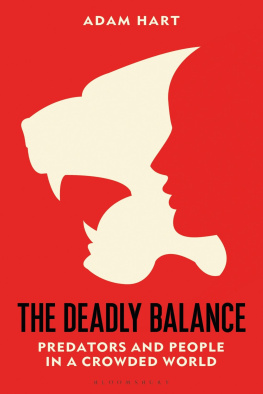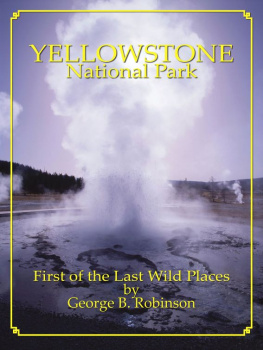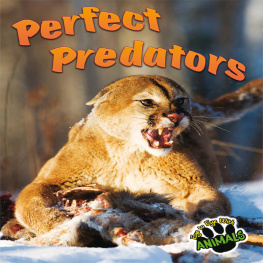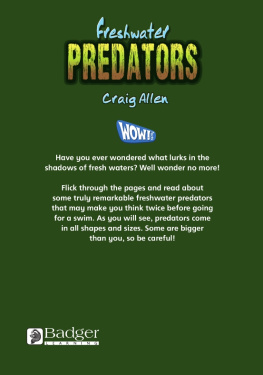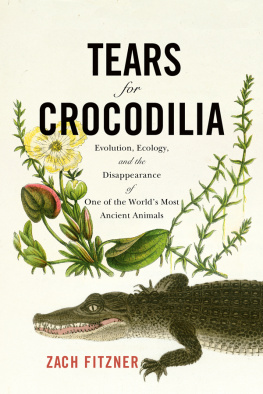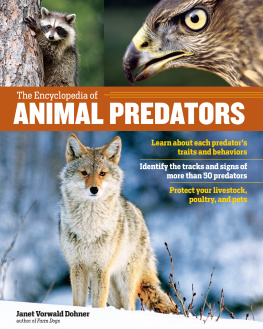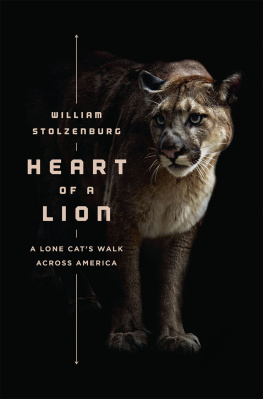WHERE THE WILD THINGS WERE
Life, Death, and Ecological Wreckage in a Land of Vanishing Predators
William Stolzenburg

Contents
To Mom and Dad
PROLOGUE:
The Grizzly in the Room
ANYONE WHO WRITES a book of science about great, flesh-eating beasts should be required up front to disclose their bias. Here is mine.
The second week of June 2000, on the campus of the University of Montana in Missoula, nearly a thousand professional biologists and advanced students had gathered for the fourteenth annual meeting of the Society for Conservation Biology. As a science writer covering that conference, I was to navigate the chaos of some four hundred presentationsgoing off eight at a time, thirty-two to the hour, three days straight, in various locations about campus. My reporting strategy, honed to questionable success with years of practice, was to scramble hither and yon in manic pursuit of the most captivating titles, the next great thing in conservation, as one might try fielding an exploding batch of popcorn.
Within fifteen minutes of the first days opening sessions, that strategy had been scrapped for an infinitely more alluring one. I had found a seat in a symposium called The Role of Top Predators in Ecological Communities and Biological Conservation, and for the next three hours I made no pretenses of needing to be anywhere else.
Because here were stories of lions, hyenas, and leopards, battling cheetahs and wild dogs over bloody carcasses on the African plains. Here were tales of wolves raising the neck hairs on moose in Alaska, rogue killer whales gobbling sea otters in the Aleutians, even coyotes chasing house cats in California suburbs. Here, one after the next, were legitimately visceral alternatives to filing yet another pale report on habitat fragmentation, population viability analyses, or microsatellite loci.
The faces materializing at the podium, the names appearing on the papers, included some of the icons and iconoclasts of conservation biology. There was James A. Estes, pioneering marine biologist whose observations in the Aleutians thirty years earlier had revealed the sea otter as resurrected guardian angel of the vibrant Pacific kelp forest. Estes was back from yet another season in the cold northern waters, with a bizarre new twist in the otters comeback storya twist involving otter-eating killer whales, whose punch line still has the marine science community feuding.
Estes also brought a message from his coauthor John Terborgh, a legendary tropical ecologist with nightmarish news from a surreal, predator-free archipelago in Venezuela, whose forests in the absence of harpy eagles and jaguars were being eaten to the ground. There was Joel Berger, noted authority on large hoofed animals, diagnosing a strange case of amnesia in the Grand Teton range of Wyoming, where the moose had forgotten certain essential fearsan unfortunately lethal lapse now that wolves had recently reclaimed lost ground in the Tetons.
Later that afternoon, Bergers colleague Peter Stacey was revealing more wounds of missing predators. Streamside birds of the Grand Teton had disappeared, in a chain reaction eventually traced back to the mountains missing wolves and grizzlies.
The next day brought more on the science of predators and predation as increasingly vital matters in conserving lifes diversity. A progress report from Yellowstone National Park, then five years into a bold experiment of turning gray wolves loose after a seventy-year hiatus, suggested the sanctuary had been decidedly shortchanged in the wolves absence. The reinstated top predator, reported lead researcher Douglas Smith, was turning the park into a banquet of elk carrion, with a slew of scavenging species reaping the leftovers. It would turn out these were the rumblings of bigger tremors to come; Smith and his colleagues were sitting cautiously on preliminary findings of a wholesale revival of Yellowstones compromised ecosystem, courtesy of the wolf.
Talk after talk, northern seas to tropical jungles, the conclusions rang in accord, as with a gavel: Big predators were not just missing; they were sorely missed. It brought to mind a medical phenomenon haunting many amputees; the phantom pains of a missing limb. These top predatorsthese missing limbswere still deeply felt.
Here, in a country whose society had blown away all but a token remnant of its topmost competitors, was a force of top-flight ecologists exposing the campaign as a colossal case of shooting ones own foot. Here was evidence that the biggest and scariest of carnivores were more dangerous by their absence. It was time, as Jim Estes addressed his audience, to rethink the way we look at the world, to consider the view from the top downfrom the predators perspective.
From that day I began tracking this insurgent cadre of concerned scientists taking stock of Earths increasingly fangless kingdom. Theirs is the story of this book. In field sites spanning the biosphere, these ecologists are questioning the soundness of ecosystems recently devoid of their topmost predators, and discovering suspicious cracks in the foundation. They are flagging, in a sense, what the bard of ecology Aldo Leopold once described as the marks of death in a community that believes itself well. And I hope, if nothing else, that through the following chronicle of their discoveries, these unseen wounds and phantom pains, whose source scientists are now bringing to light, may at least be made visible for all of us to deal with as we choose.
But again to that sticky business of bias. There is a reason these discoveries have been so late in coming andas well seeso warily received. The ecology of big predators remains the most intractable discipline in the most complex of all sciences. Its subjects are hard to find, and harder yet to hold still for study. The big predators are not only inherently rareas ordained by their tiny perch atop the food pyramidbut fashionably rare, at the hands of a modern human society that slaughters them blatantly out of contempt and obliquely through wholesale destruction of their homes and livelihoods. These are animals that tend to roam too far for conventional observation, considering that a weeks jaunt by a lovelorn wolf may span entire western states. The great carnivores, like lions melting into the tall grass, are also by nature enigmatic and stealthy, and dangerous when cornered. Their intimate study poses logistical and psychological issues unknown to the biologist studying deer or beetles.
And therein lies one confounding variable that inescapably pervades this supposed book of fact and systematic inquiry. Over the thousands of millennia that our own lineage has spent in the company of killing beastscompeting with them for food and running from them as foodthe great meat-eaters have quite naturally etched themselves into the human persona. Long before people had perfected the art of exterminating their fellow predators, they were worshipping them. Thirty thousand years ago, Paleolithic artists were decorating cave walls with reverently painted murals of lions. To this day no human, scientist or otherwise, impassively witnesses the disembowelment of a living creature by the tearing jaws and claws of wild carnivores. No one impartially records the soul-jarring charge of a grizzly bear or the mountain-hushing howl of the wolf.
The question hanging over that Missoula gathering was palpable, and it has stalked this story to the end. All this talk of killing and fleeing and ecological chain reactions made for stirring copy, but was it legitimate? Were these the reports of sound science or the veiled advocacy of a few who had fallen prey to the predators mystique? More to the heart, what would it mean to the human animal to one day wake up and find itself in a world where the biggest, most threatening predator in the whole blessed menagerie was a coyote the size of a border collie? These concerns were pertinent not only to the predator ecologist advocating conservation but also to the journalist who would question their conclusions. Something more than science pervaded the discussionssomething akin to the five-hundred-pound grizzly in the room.


